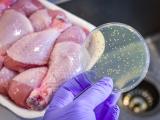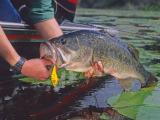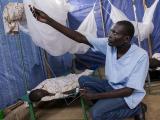Mar 3, 2006 (CIDRAP News) The Food and Drug Administration (FDA) this week proposed voluntary guidelines to help food processors reduce the risk of pathogenic contamination of fresh-cut produce such as bagged salads and sliced pineapple.
Fresh produce has been blamed for a growing share of foodborne disease outbreaks in recent years, and in October 2004 the FDA announced an action plan for reducing disease risks linked to produce.
In releasing the draft guidelines, Acting FDA Commissioner Dr. Andrew von Eschenbach said in a news release, "Fresh-cut produce is the fastest growing sector of the fresh produce industry. This document should help to improve safety by providing clearer guidance on how to reduce health hazards that are potentially introduced during the production process."
Processes such as slicing, peeling, coring, and trimming increase the risk of bacterial contamination of produce by breaking the skin, the FDA noted. Examples of fresh-cut products include shredded lettuce and cabbage, peeled baby carrots, broccoli and cauliflower florets, cut celery stalks, and sliced melons.
The guidance document, titled "Guide to Minimize Microbial Food Safety Hazards of Fresh-cut Fruits and Vegetables," offers recommendations in five areas: personnel health and hygiene, personnel training, building and equipment, sanitation operations, and production and processing controls (such as packaging, storage, and transport).
The FDA said the document recommends that produce processors encourage their partners throughout the supply chain to use safe practices, including requiring workers to report illnesses and training supervisors to recognize signs of infectious disease and not allow sick employees to work until they have been treated.
Many companies that market fresh-cut produce report they already are using many of the practices recommended in the guidelines, according to a report published today in the Monterey County Herald, in California's Salinas Valley, a major produce-growing area.
Eric Schwartz, president of Dole Fresh Vegetables, told the newspaper his company is already following 90% of the guidelines. "I think most of your big players are doing something very similar now," he was quoted as saying.
Remarking that he had seen produce operations in facilities that were "one step up from a barn," Schwartz said Dole would like to see the FDA turn the guidelines into requirements.
The story said the guidelines were developed with the help of the produce industry. Hank Giclas, an official with the Western Growers Association, told the newspaper, "It's a document we've been asking for for some time, so I'm happy to see them get it out on the street."
In releasing its produce-safety action plan in October 2004, the FDA cited an estimate that at least 12% of illness cases in outbreaks in the 1990s were tied to fresh produce. The action plan focused mainly on providing more information to produce growers, processors, transporters, retailers, and consumers, rather than on regulations.
Last December the consumer group Center for Science in the Public Interest (CSPI) said that contaminated fruits and vegetables had caused more illness cases in recent years than any other food group.
Between 1990 and 2003, produce and produce dishes were linked to 554 outbreaks totaling more than 28,000 illness cases, according to the CSPI analysis. Poultry was second, with 476 outbreaks totaling more than 14,000 cases.
The Monterey County Herald report said the FDA wrote a "scathing letter" last November urging fresh-cut produce companies to do more to protect consumers from foodborne pathogens.
The FDA is taking comments on the proposed guidelines for 60 days. (See news release link below for details on how to comment.)
See also:
Mar 1 FDA news release
http://www.fda.gov/NewsEvents/Newsroom/PressAnnouncements/2006/ucm108610.htm
Dec 1, 2005, CIDRAP News story "Produce linked to more disease cases than poultry"
Oct 18, 2004, CIDRAP News story "FDA lists plans for making produce safer"

















